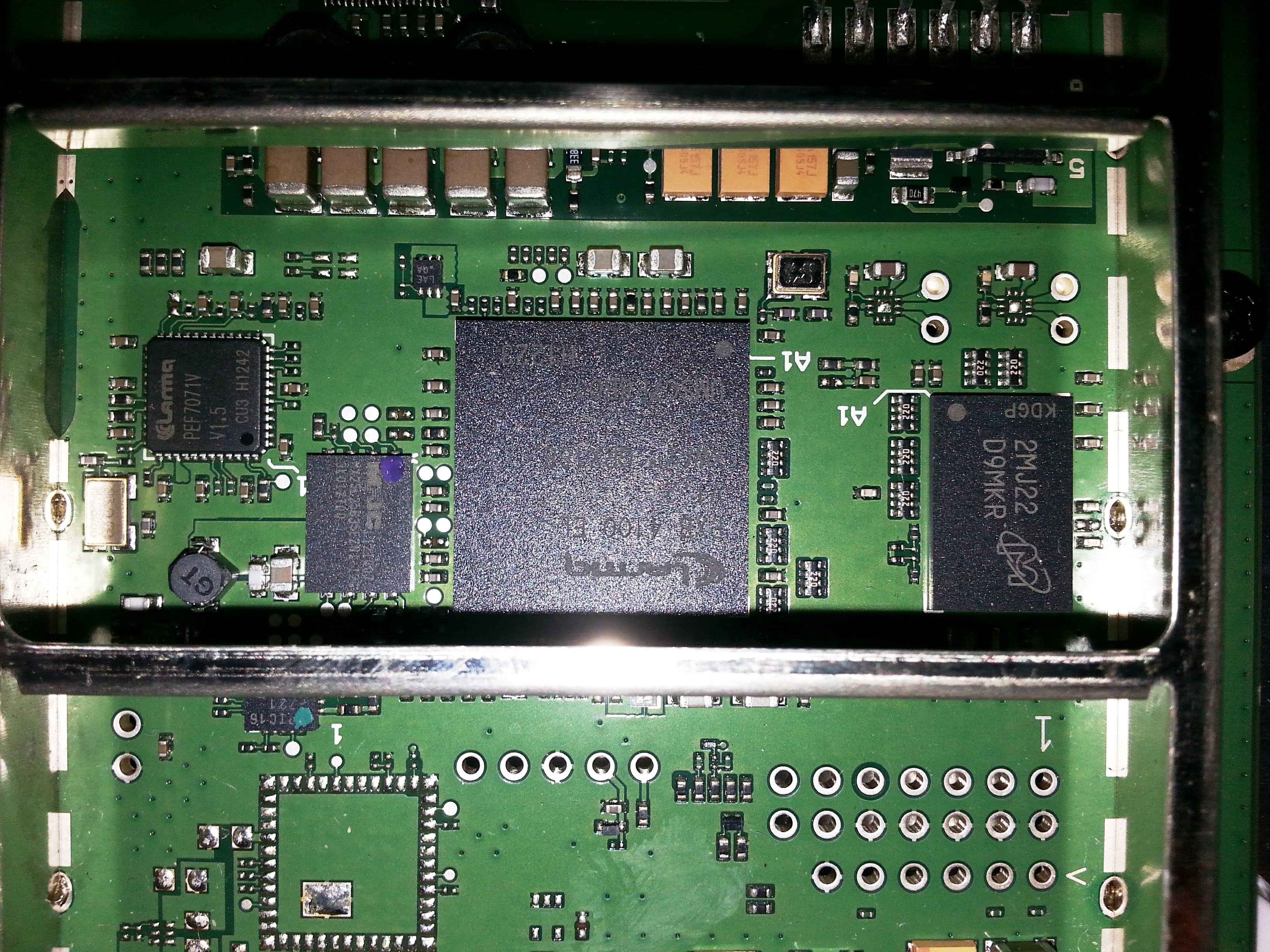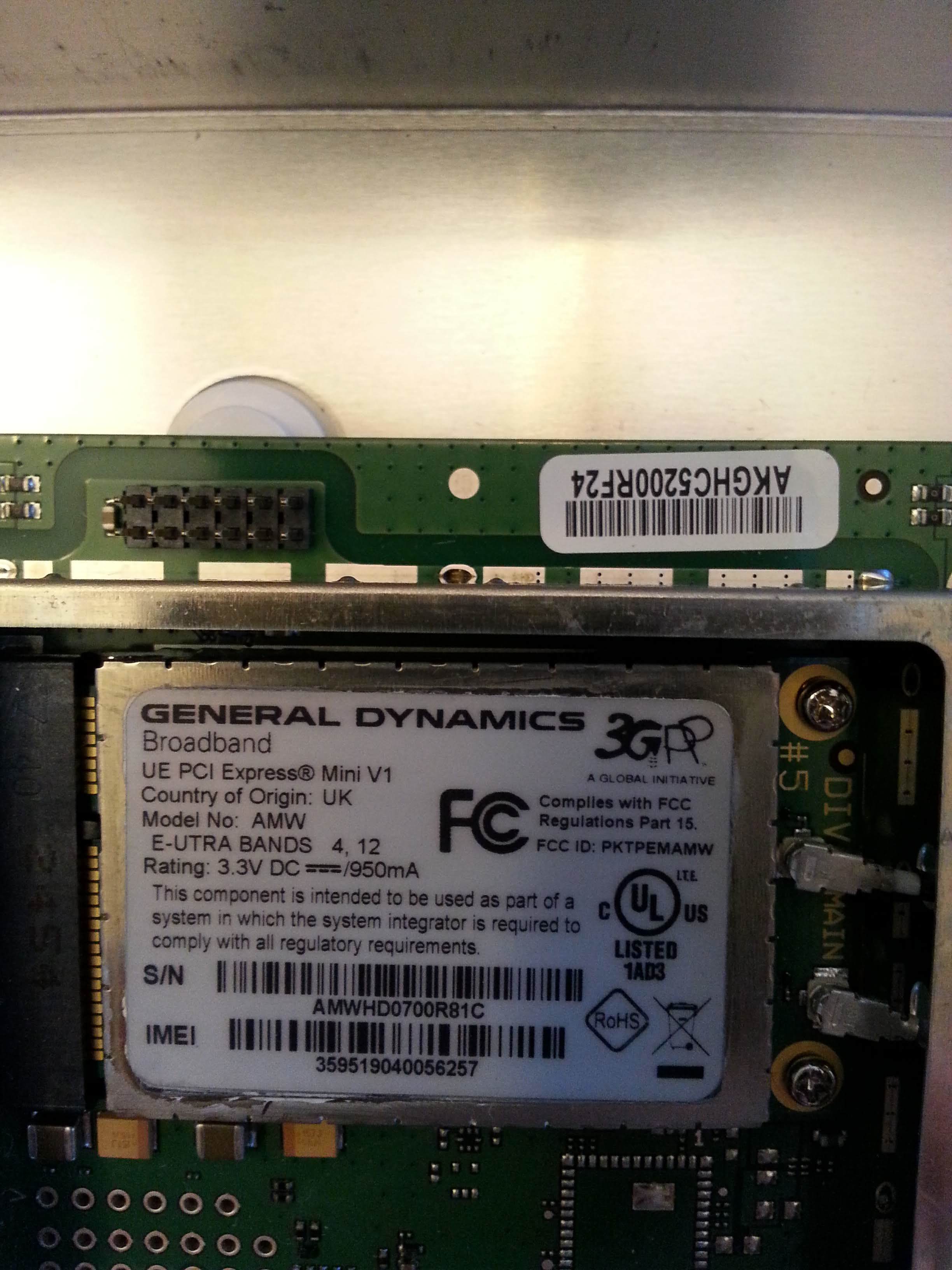Unless it's unlocked and multi-band, you might could only activate it on T-Mobile and/or MetroPCS...the FCC data appears to show 2 bands available in the older model, and 4 bands in the other.
Given that many components of OpenWRT are licensed under GPL, assuming that the device is within the window of responsibility of those licenses, you should be able to request the full GPL disclosure on the unit.
Yes these are unlocked and only do LTE Bands 4 & 12.
I seen a lot of devices that need band 17 will use band.
AT&T and T-Mobile use LTE bands 4 and 12.
But I only need it for t-mobile because they have the best price on data.
Sorry about all the jpgs.
Thank You
root@ipwcpe:/# cat /proc/cpuinfo
system type : AR9
processor : 0
cpu model : MIPS 34Kc V4.12
BogoMIPS : 222.00
wait instruction : yes
microsecond timers : yes
tlb_entries : 16
extra interrupt vector : yes
hardware watchpoint : yes, count: 4, address/irw mask: [0x0000, 0x0020, 0x08a0, 0x0010]
ASEs implemented : mips16 dsp mt
shadow register sets : 1
core : 0
VCED exceptions : not available
VCEI exceptions : not available
root@ipwcpe:/# cat /proc/mtd
dev: size erasesize name
mtd0: 00020000 00008000 "uboot"
mtd1: 00200000 00008000 "kernel"
mtd2: 00a00000 00008000 "rootfs"
mtd3: 00400000 00008000 "sysconfig"
mtd4: 00008000 00008000 "ubootconfig"
mtd5: 00008000 00008000 "fwdiag"
mtd6: 00200000 00008000 "kernel2"
mtd7: 00a00000 00008000 "rootfs2"
mtd8: 00008000 00008000 "bankselect"
mtd9: 00008000 00008000 "bankselect2"
mtd10: 00008000 00008000 "ipwconfig"
mtd11: 00008000 00008000 "ipwconfig2"
mtd12: 003b0000 00008000 "spare"
root@ipwcpe:/# dmesg
<5>Linux version 2.6.32.32 (mthurlow@ipwuk-lb01.ipwireless.com) (gcc version 4.3 .3 (GCC) ) #1 Thu Nov 1 16:21:29 GMT 2012
<4>phym = 02000000, mem = 01f00000, max_pfn = 00001f00
<4>Reserving memory for CP1 @0xa1f00000, size 0x00100000
<6>CPU revision is: 0001954c (MIPS 34Kc)
<6>Determined physical RAM map:
<6>User-defined physical RAM map:
<6> memory: 01f00000 @ 00000000 (usable)
<6>Initrd not found or empty - disabling initrd
<4>Zone PFN ranges:
<4> Normal 0x00000000 -> 0x00001f00
<4>Movable zone start PFN for each node
<4>early_node_map[1] active PFN ranges
<4> 0: 0x00000000 -> 0x00001f00
<7>On node 0 totalpages: 7936
<7>free_area_init_node: node 0, pgdat 80374f90, node_mem_map 81000000
<7> Normal zone: 62 pages used for memmap
<7> Normal zone: 0 pages reserved
<7> Normal zone: 7874 pages, LIFO batch:0
<4>Built 1 zonelists in Zone order, mobility grouping on. Total pages: 7874
<5>Kernel command line: root=/dev/mtdblock2 rw rootfstype=jffs2 ip=192.168.1.1:1 92.168.1.2::::eth0:on console=ttyS1,115200 ethaddr=00:E0:92:00:01:40 phym=32M me m=31M panic=1 mtdparts=ifx_sflash:128k@0x0(uboot),2m@0x1030000(kernel),10m@0x123 0000(rootfs),4m@0xC20000(sysconfig),32k@0x1020000(ubootconfig),32k@0x1028000(fwd iag),2m@0x20000(kernel2),10m@0x220000(rootfs2),32k@0x1C30000(bankselect),32k@0x1 C38000(bankselect2),32k@0x1C40000(ipwconfig),32k@0x1C48000(ipwconfig2),3776k@0x1 C50000(spare) init=/etc/preinit quiet vpe1_load_addr=0x81f00000 vpe1_mem=1M ethw an=2
<6>PID hash table entries: 128 (order: -3, 512 bytes)
<6>Dentry cache hash table entries: 4096 (order: 2, 16384 bytes)
<6>Inode-cache hash table entries: 2048 (order: 1, 8192 bytes)
<4>Primary instruction cache 32kB, VIPT, 4-way, linesize 32 bytes.
<4>Primary data cache 16kB, 4-way, VIPT, no aliases, linesize 32 bytes
<6>Writing ErrCtl register=0003f8e5
<6>Readback ErrCtl register=0003f8e5
<6>Memory: 27480k/31744k available (2978k kernel code, 4264k reserved, 556k data , 188k init, 0k highmem)
<6>Hierarchical RCU implementation.
<6>NR_IRQS:185
<6>Lantiq ICU driver, version 3.0.1, (c) 2001-2011 Lantiq Deutschland GmbH
<6>console [ttyS1] enabled
<6>Calibrating delay loop... 222.00 BogoMIPS (lpj=1110016)
<6>Security Framework initialized
<4>Mount-cache hash table entries: 512
<6>NET: Registered protocol family 16
<4>bio: create slab <bio-0> at 0
<5>SCSI subsystem initialized
<6>usbcore: registered new interface driver usbfs
<6>usbcore: registered new interface driver hub
<6>usbcore: registered new device driver usb
<6>Switching to clocksource MIPS
<6>NET: Registered protocol family 2
<6>IP route cache hash table entries: 1024 (order: 0, 4096 bytes)
<6>TCP established hash table entries: 1024 (order: 1, 8192 bytes)
<6>TCP bind hash table entries: 1024 (order: 0, 4096 bytes)
<6>TCP: Hash tables configured (established 1024 bind 1024)
<6>TCP reno registered
<6>NET: Registered protocol family 1
<6>gptu: totally 6 16-bit timers/counters
<6>gptu: misc_register on minor 63
<6>gptu: succeeded to request irq 118
<6>gptu: succeeded to request irq 119
<6>gptu: succeeded to request irq 120
<6>gptu: succeeded to request irq 121
<6>gptu: succeeded to request irq 122
<6>gptu: succeeded to request irq 123
<6>IFX DMA driver, version ifxmips_dma_core.c:v1.0.17
<6>,(c)2009 Infineon Technologies AG
<6>Lantiq CGU driver, version 1.1.27, (c) 2001-2011 Lantiq Deutschland GmbH
<4>vpe1_mem = 100000
<4>Wired TLB entries for Linux read_c0_wired() = 0
<4>Registering mini_fo version $Id$
<6>JFFS2 version 2.2. © 2001-2006 Red Hat, Inc.
<6>msgmni has been set to 53
<4>Line: 127, function: deu_init
<6>Infineon Technologies DEU driver version 2.0.0
<5>IFX DEU DES initialized (multiblock).
<5>IFX DEU AES initialized (multiblock).
<5>IFX DEU ARC4 initialized (multiblock).
<5>IFX DEU SHA1 initialized.
<5>IFX DEU MD5 initialized.
<5>IFX DEU SHA1_HMAC initialized.
<5>IFX DEU MD5_HMAC initialized.
<6>io scheduler noop registered (default)
<6>ifx_pmu_init: Major 252
<6>Lantiq PMU driver, version 1.2.2, (c) 2001-2011 Lantiq Deutschland GmbH
<6>Lantiq GPIO driver, version 1.2.14, (c) 2001-2011 Lantiq Deutschland GmbH
<6>Infineon Technologies RCU driver version 1.0.8
<6>Lantiq LED Controller driver, version 1.0.6, (c) 2001-2011 Lantiq Deutschland GmbH
<6>ttyS0 at MMIO 0xbe100400 (irq = 98) is a IFX_ASC
<6>ttyS1 at MMIO 0xbe100c00 (irq = 105) is a IFX_ASC
<6>Register ASC (UART) to PMCU.
<6>Lantiq ASC (UART) driver, version 1.0.9, (c) 2001-2011 Lantiq Deutschland Gmb H
<6>brd: module loaded
<6>loop: module loaded
<6>Lantiq SSC driver, version 2.2.6, (c) 2001-2011 Lantiq Deutschland GmbH
<5>13 cmdlinepart partitions found on MTD device ifx_sflash
<5>Creating 13 MTD partitions on "ifx_sflash":
<5>0x000000000000-0x000000020000 : "uboot"
<5>0x000001030000-0x000001230000 : "kernel"
<5>0x000001230000-0x000001c30000 : "rootfs"
<5>mtd: partition "rootfs" set to be root filesystem
<1>split_squashfs: no squashfs found in "ifx_sflash"
<5>0x000000c20000-0x000001020000 : "sysconfig"
<5>0x000001020000-0x000001028000 : "ubootconfig"
<5>0x000001028000-0x000001030000 : "fwdiag"
<5>0x000000020000-0x000000220000 : "kernel2"
<5>0x000000220000-0x000000c20000 : "rootfs2"
<5>0x000001c30000-0x000001c38000 : "bankselect"
<5>0x000001c38000-0x000001c40000 : "bankselect2"
<5>0x000001c40000-0x000001c48000 : "ipwconfig"
<5>0x000001c48000-0x000001c50000 : "ipwconfig2"
<5>0x000001c50000-0x000002000000 : "spare"
<6>Lantiq SPI flash driver, version 1.1.9, (c) 2001-2011 Lantiq Deutschland GmbH
<6>PPP generic driver version 2.4.2
<6>PPP Deflate Compression module registered
<6>PPP BSD Compression module registered
<6>PPP MPPE Compression module registered
<6>NET: Registered protocol family 24
<6>IMQ driver loaded successfully.
<6> Hooking IMQ after NAT on PREROUTING.
<6> Hooking IMQ after NAT on POSTROUTING.
<4>IFX SWITCH API, Version 1.1.7.2
<6>SWAPI: Registered character device [switch_api] with major no [81]
<6>Registered led device: internet_led
<6>Registered led device: broadband_led
<6>Registered led device: internet_red_led
<6>Registered led device: wps_red_led
<6>Registered led device: ledc_4
<6>Registered led device: ledc_5
<6>Registered led device: ledc_6
<6>Registered led device: voip_led
<6>Registered led device: ledc_8
<6>Registered led device: wps_led
<6>Registered led device: ledc_11
<6>Registered led device: ledc_12
<6>Registered led device: ledc_13
<6>Registered led device: ledc_14
<6>Registered led device: wireless_led
<6>Lantiq LED driver, version 1.0.17, (c) 2001-2011 Lantiq Deutschland GmbH
<4>u32 classifier
<4> Performance counters on
<4> input device check on
<4> Actions configured
<4>nf_conntrack version 0.5.0 (429 buckets, 1716 max)
<4>ip_conntrack_rtsp v0.6.21 loading
<6>xt_time: kernel timezone is -0000
<6>IPv4 over IPv4 tunneling driver
<6>GRE over IPv4 tunneling driver
<4>ip_nat_rtsp v0.6.21 loading
<6>ip_tables: (C) 2000-2006 Netfilter Core Team
<6>TCP cubic registered
<6>Initializing XFRM netlink socket
<6>NET: Registered protocol family 10
<6>lo: Disabled Privacy Extensions
<6>tunl0: Disabled Privacy Extensions
<6>NET: Registered protocol family 17
<6>NET: Registered protocol family 15
<6>802.1Q VLAN Support v1.8 Ben Greear <greearb@candelatech.com>
<6>All bugs added by David S. Miller <davem@redhat.com>
<4>VFS: Mounted root (jffs2 filesystem) on device 31:2.
<6>Freeing unused kernel memory: 188k freed
<4>Please be patient, while OpenWrt loads ...
<4> External Switch ID :0x0000ffff
<4>Unrecognised PHY ID 0xFFFFFFFF at address 0x00
<4>Unrecognised PHY ID 0xFFFFFFFF at address 0x01
<4>Unrecognised PHY ID 0xFFFFFFFF at address 0x02
<4>Unrecognised PHY ID 0xFFFFFFFF at address 0x03
<4>Unrecognised PHY ID 0xFFFFFFFF at address 0x04
<4>Unrecognised PHY ID 0xFFFFFFFF at address 0x05
<4>Unrecognised PHY ID 0xFFFFFFFF at address 0x06
<4>Unrecognised PHY ID 0xFFFFFFFF at address 0x07
<4>Unrecognised PHY ID 0xFFFFFFFF at address 0x08
<4>Unrecognised PHY ID 0xFFFFFFFF at address 0x09
<4>Unrecognised PHY ID 0xFFFFFFFF at address 0x0A
<4>Unrecognised PHY ID 0xFFFFFFFF at address 0x0B
<4>Unrecognised PHY ID 0xFFFFFFFF at address 0x0C
<4>Unrecognised PHY ID 0xFFFFFFFF at address 0x0D
<4>Unrecognised PHY ID 0xFFFFFFFF at address 0x0E
<4>Unrecognised PHY ID 0xFFFFFFFF at address 0x0F
<4>Unrecognised PHY ID 0xD565A401 at address 0x10
<4>Unrecognised PHY ID 0xFFFFFFFF at address 0x11
<4>Unrecognised PHY ID 0xFFFFFFFF at address 0x12
<4>Unrecognised PHY ID 0xFFFFFFFF at address 0x13
<4>Unrecognised PHY ID 0xFFFFFFFF at address 0x14
<4>Unrecognised PHY ID 0xFFFFFFFF at address 0x15
<4>Unrecognised PHY ID 0xFFFFFFFF at address 0x16
<4>Unrecognised PHY ID 0xFFFFFFFF at address 0x17
<4>Unrecognised PHY ID 0xFFFFFFFF at address 0x18
<4>Unrecognised PHY ID 0xFFFFFFFF at address 0x19
<4>Unrecognised PHY ID 0xFFFFFFFF at address 0x1A
<4>Unrecognised PHY ID 0xFFFFFFFF at address 0x1B
<4>Unrecognised PHY ID 0xFFFFFFFF at address 0x1C
<4>Unrecognised PHY ID 0xFFFFFFFF at address 0x1D
<4>Unrecognised PHY ID 0xFFFFFFFF at address 0x1E
<4>Unrecognised PHY ID 0xFFFFFFFF at address 0x1F
<6>IFX 3 Port Switch Eth driver, version ifxmips_3port_sw.c:v1.0.7
<6>,(c)2009 Infineon Technologies AG
<6>IFXOS, Version 1.5.14 (c) Copyright 2009, Lantiq Deutschland GmbH
<6>
<6>device eth0 entered promiscuous mode
<6>br0: port 1(eth0) entering learning state
<6>br0: port 1(eth0) entering forwarding state
<6>usbcore: registered new interface driver ueservice
<6>usbcore: registered new interface driver cdc_ether
<6>usbcore: registered new interface driver ue_lte
<6>IFXUSB: ifxusb_hcd: version 3.2 B120208
<6>IFXUSB: USB core #0 soft-reset
<6>IFXUSB: USB core #0 soft-reset
<6>ifxusb_hcd ifxusb_hcd: IFX USB Controller
<6>ifxusb_hcd ifxusb_hcd: new USB bus registered, assigned bus number 1
<6>ifxusb_hcd ifxusb_hcd: irq 54, io mem 0xbe101000
<6>IFXUSB: Init: Power Port (0)
<6>usb usb1: configuration #1 chosen from 1 choice
<6>hub 1-0:1.0: USB hub found
<6>hub 1-0:1.0: 1 port detected
<6>usb 1-1: new high speed USB device using ifxusb_hcd and address 2
<6>usb 1-1: configuration #1 chosen from 1 choice
<6>lte0: register 'ue_lte' at usb-ifxusb_hcd-1, IPWireless LTE device - driver v ersion 1.0.0.6, 00:04:d8:7f:0e:29
<6>ADDRCONF(NETDEV_UP): lte0: link is not ready
<6>ADDRCONF(NETDEV_CHANGE): lte0: link becomes ready
root@ipwcpe:/# df
Filesystem 1024-blocks Used Available Use% Mounted on
/dev/root 10240 5376 4864 53% /
root@ipwcpe:/etc# ls
TZ init_a5.script preinit
banner init_a5_2.script profile
cmv_batch init_d5.script protocols
codeclist init_d5_2.script rc.common
config inittab rc.conf
config.sh iproute2 rc.conf.gz
crontabs ipsec.conf rc.d
device_table.txt ipsec.secrets rc.local
diag.sh ipsec1-3des.conf resolv.conf
dnrd ipsec1-aes.conf ripd.conf
dnsmasq.conf ipsec1-des.conf services
dropbear ipsec2-3des.conf shells
dsl_api ipsec2-aes.conf snmp
fstab ipsec2-des.conf snmpd.conf
functions.sh mini_httpd.conf spmd.pwd
group modules.conf sys.conf
host.conf modules.d sys.conf.device
hostapd.conf mtab sysctl.conf
hosts nsswitch.conf timestamp
hotplug.d openwrt_release tr69
hotplug2-common.rules openwrt_version uci-defaults
hotplug2-init.rules passwd udhcpd.conf
igmpproxy.conf patches.list version
ilmid pecoload.sh voip.conf.tgz
inetd.conf pecostat.sh zebra.conf
init.d ppp
root@ipwcpe:/etc# cat openwrt_release
DISTRIB_ID="OpenWrt"
DISTRIB_RELEASE="10.03"
DISTRIB_CODENAME="backfire"
DISTRIB_DESCRIPTION="OpenWrt Backfire 10.03"
root@ipwcpe:/etc# cat openwrt_version
10.03
root@ipwcpe:/etc#
That shows 32 MB of RAM, which is barely acceptable-- for simple uses it is enough but there will be problems running large applications like OpenVPN. The flash size is 32 MB which is plenty. Make sure the flash chip is something OpenWrt supports. You will need to read the number on the chip itself since it is not in the logs.
Under Backfire there is a big difference in that the file system is not writeable-- the configuration is stored as a key-value database in a special "nvram" partition.
Cleaned up a bit and removed the log posted as pictures, in favour of the now available pure text form.
I think the chip is a Lantiq PXB 4100 EL - Photo attached.

I looked closer at the chip and it says it is a xway grx168
I see that there are some builds for the arx168, but don't see any for the grx168.
Will any of them work for my device?
PXB 4100 Belhaven MIPS ??? MHz 1 ADSL2+ FE MAC w/FE PHY,
GRX100/GRX168 (PXB 4100) 0 devices [ARK] Intel-AnyWAN-GRX100-Network-Processors)
I also see the Buffalo makes a device with the Lantiq ARX168 - could one of those work for the GRX168 chip?
Thank You
The GRX chip may just be an ARX with the wifi section deleted.
Do you see a serial port on the board?
Not a DB9 serial port, but there is a port above the pci express card.
Maybe a J-Tag Port - I don't know for sure, but it is not used.
I only need a Ethernet and the PCI express card to work.
I do not need the firewall option, because I run a firewall behind this modem that does the NAT and Firewall utilities.
I will try to attach another photo with the port that I do not know what it is.
Thank You
Jeff, I cannot connect to the 'User Manual' link above.
Yes I am connecting with telnet and/or http.
But http has very limited options to config the device.
Thank You,